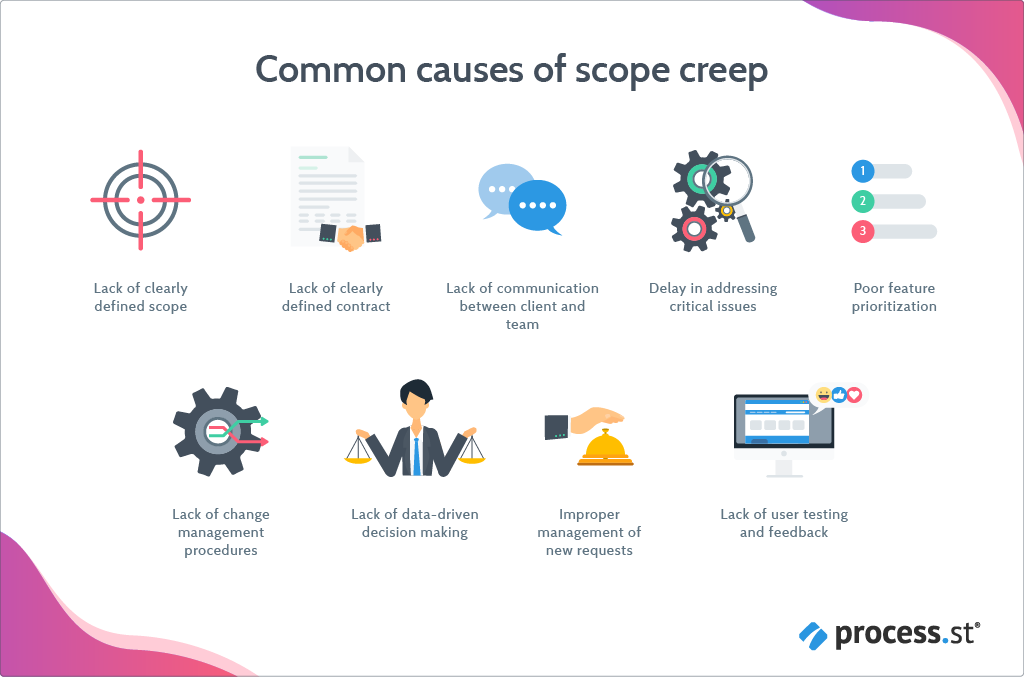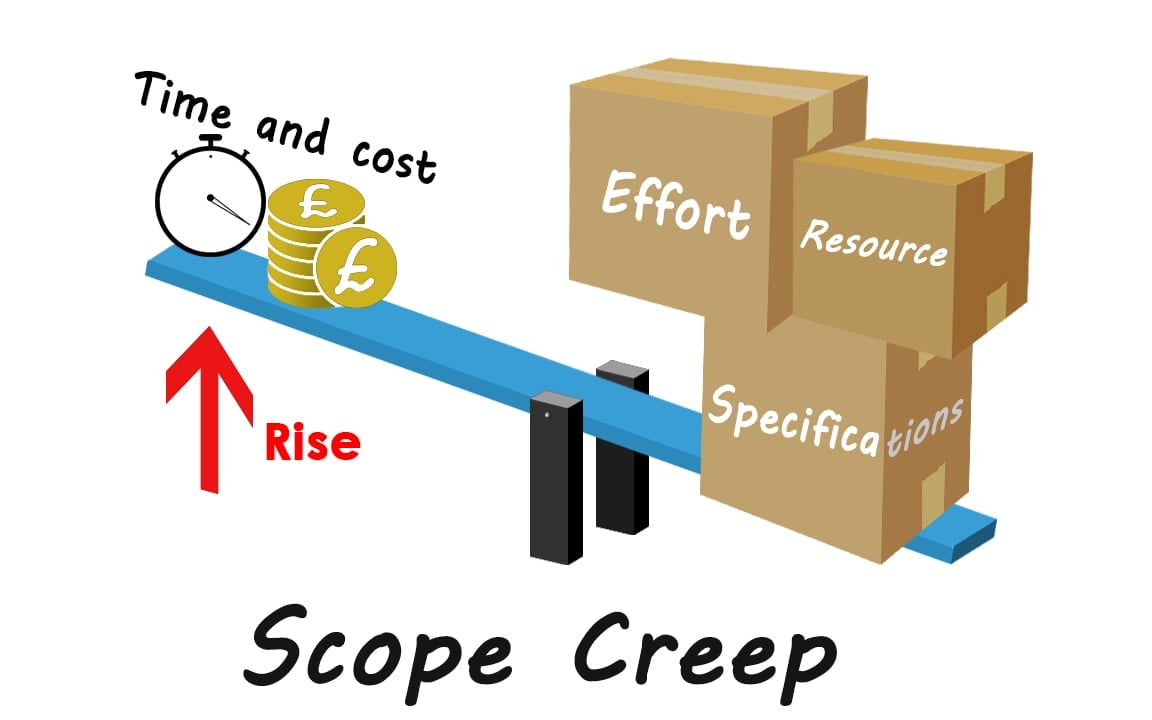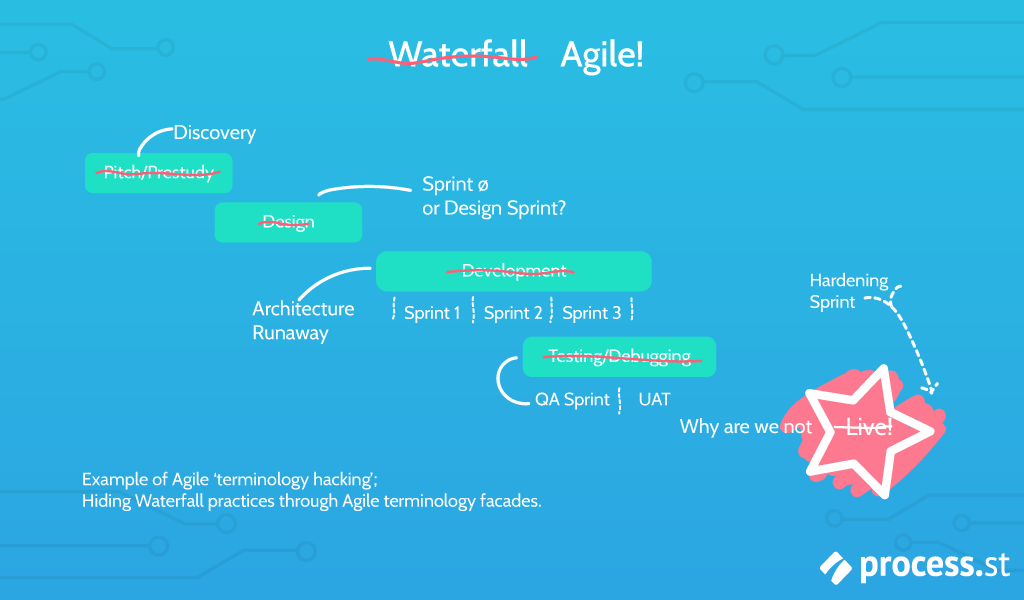
This is a guest post written by Ashley Ferro, a freelance content writer & copywriter specializing in SEO content marketing.
There’s nothing more frustrating to a project manager than witnessing the slow, painful death of a healthy project to the beast known as scope creep. When last minute changes transform their straightforward, A-to-B project plan into a sprawling mess of up-ended sprint plans and gold-plated feature requests, branching out in all directions with no concern for time or resources.
In one extreme example, the head contractor for the extension of a city library ended up actually suing their client in a scope-creep induced rage, claiming that their almost 55-week delay was a direct result of the large number of last minute changes.
In order for a project to be successfully completed on time, the project manager and their team need to agree on a clearly defined project scope before getting started.
However, life isn’t so straight forward and changes to the project will inevitably need to happen.
But additional problems can arise if the changes aren’t dealt with properly.
Scope creep can quietly sneak its way into your project and set your team down an unproductive and self-destructive path, wasting your company’s resources, missing deadlines, weakening team communication and, ultimately, ruining any chance of your project’s success.
So what can you do to avoid this fate, and overcome scope creep once and for all?
In this Process Street article, we’ll be covering everything you need to know scope creep–from what (and who) causes it, to how to manage it, even in an agile environment where change is embraced.
We’ll be covering:
- What is scope creep?
- How different stakeholders can contribute to scope creep
- What are some common causes of scope creep?
- Most effective ways to manage scope creep
- What we can learn from Agile to prevent scope creep?
- Using Process Street to avoid scope creep
- Additional project management resources
If, however, you’re struggling with planning your own projects and want a quick solution, grab our free Project Request Form Template below!
So, let’s get started with the basics!
What is scope creep?
In simple terms, scope creep is when the scope of a project increases from what was originally planned for.
Scope creep is actually quite common when managing projects, and can occur due to unintentional causes such as poor planning or even more intentional causes like unrealistic expectations from stakeholders.
Whatever the cause may be, scope creep can be detrimental to a project’s success. It can lead to missed deadlines, frivolously wasted time and money, and a finished project that may just miss the mark.
How different stakeholders can contribute to scope creep

Making an effort to pinpoint exactly who may be responsible for your project’s scope creep is an incredibly important step in resolving it.
Oftentimes, the blame gets placed on the client; and though that is sometimes the case, it’s not always accurate.
The colleague
In many cases, scope creep can arise from the colleagues you’re working on the project with.
This can be for a few reasons:
1. Your colleague does not have a clear understanding of the project scope
In order to avoid this, you must make sure to openly communicate the project’s deliverables and requirements to your team before beginning to work on it. If possible, involve your team in the process of setting up the project scope; or at the very least, conduct a meeting with them after the scope has been set to give them a thorough rundown.
After you’re sure your team fully understands the scope and they’ve begun work, be sure to check up on them regularly throughout the process to make sure everything is coming along as planned and there are no issues.
2. Your colleagues do not want to follow the scope
It’s one thing to make sure your team understands the project scope, but what if they deviate from it and work on what they want instead?
This can be avoided by involving your colleagues in the process of developing the project scope to begin with, so they can have an opportunity to offer their own input and feel better connected with the scope. Everyone working together as a team allows for more successfully realized projects.
3. Your colleague unknowingly makes a decision that has a negative domino effect
No process is perfect. Part of working on a project is resolving a number of small problems along the way. But when choosing a solution for these problems, your team must make sure to consider the potential consequences for their choice.
Some solutions that may offer a temporary fix to the issue could have detrimental effects on the project’s success. For example, you may end up wasting more resources, or spending more time on the project than planned for.
Top management
Sometimes, top management priorities may not align with the scope of your project. For instance, they may want to please the client no matter the inconvenience it may cause your project timeline, because they would rather preserve the relationship between your organization and the client above all else.
To address this, it’s best that you clearly communicate with top management and make sure they understand the details of your project scope and the importance of its adherence. Outline to them the potential risks of not meeting these requirements, so they can wholly understand the situation and respect it.
Customer feedback
Customer feedback is an incredibly important part of realizing projects and/or building products. On the other hand, addressing customer concerns can easily turn your project into an unmanageable and unproductive feedback loop and, ultimately, set you back significantly.
But what if you receive customer feedback that points out something significant that needs change? In these cases, you and your team should absolutely address the feedback, even if it negatively affects your scope. The key is reviewing your customer feedback and assessing their urgency to determine whether or not it’s worth potentially delaying the project to address.
The project manager
Yes, even you.
Though your intention as a project manager is always to guide your team to complete projects efficiently and effectively, sometimes issues can arise that require crucial changes (like budget, deadlines, etc.) to be requested.
But the longer these requests are put off, the more likely it is that your entire project will be delayed. I guarantee that the conversation coming from a project delay would be much more difficult to have with top management/clients than the initial request for changes would have been.
The client
Lastly — and perhaps the most obvious — is the client. If boundaries are not firmly established early on, some clients may try to add more requests, or make changes, after work has already begun. This can easily end up wasting your organization’s time and money if it isn’t managed properly at the start.
Don’t be afraid of being firm with your clients. If they are requesting something that you know will cause scope creep, be honest with them and communicate with them about your limitations. Delaying proper communication will only result in missed deadlines and frustrated clients.
What are some common causes of scope creep?

Lack of clearly defined scope
Before beginning any project, it’s incredibly important to clearly define the project scope, so that you and your team have a clear understanding of everything that needs to be done, without any need for deviation.
But as mentioned earlier, you must not only define the scope, but also effectively communicate it with everyone involved with the project. This will leave little room for delays that are due to any confusion amongst your project team.
Lack of clearly defined contract
Establishing a clearly defined client agreement means that your client will be fully aware of the project’s timeline and limitations. When clients don’t fully understand the project scope, it makes it more likely that they will ask for additional requests, or make changes, during the project’s process. This will only set your team back.
To avoid this, it’s recommended that you conduct an initial meeting with your client to discuss the project scope in detail and draft out a client agreement for them to approve, before beginning any work on the project.
Lack of communication between client and team
Now, even if you’ve held a meeting with your client and clearly communicated the project scope with them at the start, it doesn’t mean you shouldn’t keep them in the loop during the process. The longer you go without updating your client with the project’s progress, the more likely it will be that your client will request surprise changes, and in turn, negatively impact the project timeline and costs.
Make a consistent effort to keep your client in the loop during every step of the project’s process to ensure their satisfaction along the way. When you do this, you can more easily and effectively address any potential issues your client may have, before your team wastes too much time working towards something that would ultimately need to be changed.
Delay in addressing critical issues
When you delay addressing crucial issues, it will only pile up and end up pushing you and your team back. Be honest with your stakeholder or client when any issues arise to allow yourself time to address them without any effect on your scope.
Poor feature prioritization
Instead of working strictly step-by-step until you’ve finished the project, it’s best that you take some time to assess all your tasks and organize them from highest to lowest priority. Otherwise, you may be spending too much time on tasks that are not as important and may drag your project on longer than it needs to.
Try to reduce your tasks into what is absolutely necessary to finish your product, and then, if time allows, focus on the more superficial tasks.
Lack of change management procedures
Before you begin working on your project, you should decide with your team on how you will work through any changes to the scope that may arise during the process. This will allow you to quickly move through what would normally put your work at a standstill.
Work with your team during the initial project scope meeting to decide on how you will handle change, and then record it along with your scope.
Lack of data-driven decision making
No matter how much planning and deliberation you and your team may make before a project, it’s nearly impossible to be able to predict everything that may come your way during the process; and those unexpected roadblocks can end up delaying your project significantly if you’re not careful.
The best way to deal with this is to work together with your team to wholly assess the project and its requirements to come up with an appropriate estimate. Working with your team, as opposed to working alone, allows you to have multiple perspectives into the situation and help come up with as many potential risks as possible to be able to more accurately predict an appropriate project timeline.
Improper management of new requests
Always assess any new requests with your team; even if they’re coming from a trusted source. Taking on requests blindly means that you won’t have any idea how much work will be involved, what risks they come with, and so on. It just leaves the door open to the unknown.
When you receive any requests, properly review them and their requirements, until you’ve built a solid understanding of what the request is asking of you and your team and what potentially negative impact(s) it could have, if any. Only then, should you decide whether or not to take on this new request.
Lack of user testing and feedback
Keeping your users involved during the project’s process and taking into account their feedback is essential to meeting deadlines. The more you wait to seek user feedback, the more chance there will be that significant revisions will need to be made.
The last thing you want is for your team to have spent significant time on things that end up needing to be completely reworked and you end up behind schedule. To avoid this, devise a plan to address user feedback when defining the project scope and introduce users to your product/service as early as possible.
How to effectively manage scope creep

Set your project scope
As mentioned earlier, a lack of a clearly defined scope is one of the most common causes of scope creep, so making sure your project scope is set and ready to go before beginning the work is key.
Your project scope should detail your project goals, the steps you intend to take to achieve those goals, how the work will be tracked, and what resources you will need. It will serve as the framework for your project as you move forward, so in the event that, for example, something comes up that is not relevant to your project scope, then you will know it’s best to ignore it or set it as low priority.
When your project scope is clearly defined, it also gives you all the information you need to be able to precisely predict and plan out your project timeline, budget, and even solutions to potential issues that could arise. So, with this one task of setting your project scope, you can address a multitude of potential problems that could end up causing scope creep.
Having a documented project scope also gives you the upper hand when communicating with top management or stakeholders about the resources needed to complete your project. The document will speak for itself at a high enough level that the benefits of your requests would be understood without much need for further questioning.
Now, though having a clearly defined project scope is key to the success of your project, you’ll need to approach it in the right way in order to make it count. It’s important when developing your project scope, to break it down into smaller elements.
Project scope elements
Your project scope must include the following:
- Project goals
- Resulted product/service(s)
- Project process/tasks
- Timeline/deadlines
- Overall costs/budget
Though each of these elements would be useful to establish on their own, it’s most effective when all the elements are used in harmony to help build a complete picture of your project scope. A project scope that encompasses all these elements that will be effective in communicating the details of your project with stakeholders if needed.
What we can learn from Agile to prevent scope creep?

The image above is basically a tongue-in-cheek way of saying that re-naming established waterfall development phases with agile terminology will not actually make your team agile.
If you’re interested in reading more about how to root out ‘Agile BS’, we have a thorough piece on fake agile you can check out.
So, back to how we can use Agile to better prevent scope creep.
Until this point, I’ve emphasized the importance of a fixed project scope, but what if you’re following the Agile methodology where change is embraced?
Well in general, change is a good thing and you shouldn’t be afraid of it. When managed correctly, change can allow you to tweak your product until it reaches its best form in the time you have. But only when managed correctly.
The key to embracing change whilst also avoiding scope creep is to prioritize, prioritize, prioritize everything.
Whenever a new task or challenge presents itself, it’s crucial that you and your team take the time to review it and assess its level of urgency. Is the task more important than what you’re working on now? Can it wait? And if it is urgent, then you have to decide what task you’ll push back to make room for this new task and ensure that they’re equal in workload. Neglecting to prioritize your tasks is what ultimately will lead to scope creep.
It can actually be much easier to avoid scope creep when operating under Agile principles, because change is so welcomed and deeply ingrained into its methodology.
From here, we can understand how software like Process Street can help you overcome and mitigate scope creep.
Using Process Street to avoid scope creep
So, as you’ve probably gathered at this point, scope creep can be minimized by simply building a realistic project timeline and making sure you and your team are on the same page during the entire process. If one team member falls behind and no one is made aware of this, it can have a snowball effect on the success of your project.
One way to make sure everyone is doing what they’re supposed to do (and when they’re supposed to) is by using checklists. And no, not just simple checklists written on a dusty notepad to be forgotten in a desk drawer.
Process Street checklists are dynamic and practical. Features like Stop Tasks, Dynamic Due Dates, and Template Overview allow you to enforce process adherence amongst your team and monitor everyone’s progress as they work through their tasks.
Systematizing your processes helps with scope creep because it helps you to stay focused. You waste less energy on figuring out the same recurring problems/tasks over and over again and can just focus on sticking to the project plan you originally put together (in the form of a process).
For example you can use this free product roadmap checklist below to build out a clear scope for the start and finish of one of your product-focused projects.
Of course, this example is for a product roadmap, but you can easily see how having a checklist like this could be useful for avoiding scope creep. You have a clear list of tasks and a definitive start and end point in your checklist.
Now, some of those tasks will be more open ended than others; you might have sub-checklists that specify additional requirements for a task, and you might want to use Conditional Logic to build out branching processes that deal with a range of different situations and variable outcomes. But, the core structure of the checklist will still be there to help guide you from project start to project finish.
To see how real-world organizations are taking control of their processes, and thereby their projects, check out the following video featuring TechMD: https://www.youtube.com/embed/1nYiJm3TO3o?&autohide=1&modestbranding=1&showinfo=0
Additional project management resources
Here are some additional project management resources to help get you and your team on track:
- Project Scope: How to Meet Deadlines and Keep Stakeholders Happy
- How LA Creative Technologies Uses Process Street to Streamline Client Onboarding, Offboarding and Project Management
- The 21 Best Free Project Management Software (And Why They’re Great)
- 8 Smartsheet Alternatives for Superb Project Management in 2019
- Airtable vs Trello: The Best of Task and Project Management
- The 5 Project Management Steps To Run Every Project Perfectly
- Are Your Useless Tools to Blame for Bad Project Management?
- Stop Switching Between Project Management Apps — Just Integrate Them
- Project vs Process: What’s the Best Form of Management for Me?
- How to Use a Project Tracker to Keep Projects Profitable
- Visual Management: How to Communicate Effectively with Your Workforce
And some more productivity and workflow management resources you may find helpful:
- Workflow Software that Superpowers Your Team
- Business Process Management Software for Streamlined Operations
- What is BPM Software? The Best Business Process Management Software (BPMS)
- 9 Benefits of Business Process Management (BPM) and Why You’ll Love It
- Breakdown of the Best Workflow Management Software
- What is BPM Software? The Best Business Process Management Software (BPMS)
- Every To Do List Template You Need (The 21 Best Templates)
- 6 Types of Project Proposals That Get Approved (and How to Write Them)
- 10 Technology Tools Every Small Business Should Know
- Daily Routine Checklist
- 36 Workflow Apps to Save You From Data Entry Hell
- Product Launch Checklist
- Writing a Proposal: Step-by-Step Guide
- How to Boost Your Productivity in 3 Effective Ways
Have you dealt with scope creep when managing your project teams? What has worked best for you to minimize its negative effects? Let us know below in the comments. We’d love to hear from you!







Oliver Peterson
Oliver Peterson is a content writer for Process Street with an interest in systems and processes, attempting to use them as tools for taking apart problems and gaining insight into building robust, lasting solutions.